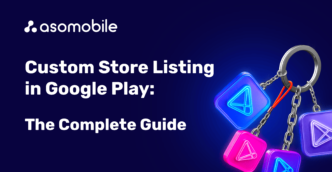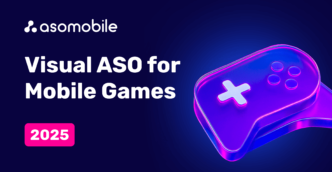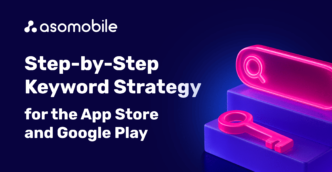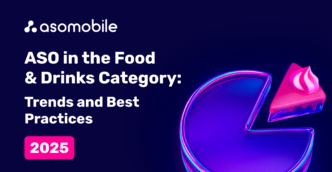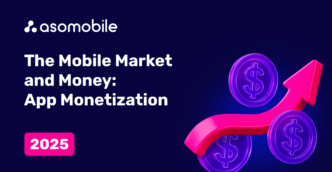SEO optimization for mobile apps
SEO for mobile apps, yes-yes, you’ve read that correctly, and no, we didn't confuse it with ASO. We want to show you how these two processes have become linked and why you should think about the representation of your app on the internet, i.e., the website. In 2019, Google noticed that most internet traffic came from mobile devices. Without thinking long, the company changed its indexing to mobile-first, or simply put, websites that have made or have a mobile version will be shown first. That's not all; let's move on to the most exciting thing that will cause you to say, "Ah-ah-ah." From that moment, Google began to offer mobile apps with keywords that match the search query. Now, let's look at what SEO or search engine optimization is. We could give a two-line definition that would only confuse you, but let's make it concise: SEO is website optimization. Still, we need to go further and say that website optimization means almost the same process as ASO, at least in concept. ASO makes our app more visible on Google Play or App Store, and SEO makes our website more visible on search engines.
SEO and ASO are the Yin and Yang for mobile optimization?
And this is where you should have known where we're leading by now. We have ASO, which has unequivocally cemented its presence in the mobile industry, and SEO, which emerged in the mid-90s. Let's be honest: SEO is likely the reason or inspiration for the emergence of ASO. What happens when you combine them? We need to understand SEO and its importance for mobile apps.
So, what is SEO specifically for mobile apps? It's that process of optimizing an app and its visibility in search engines, that is, to raise it in the rankings. And then comes the realization that this is our favorite ASO, only on a different scale and deals with a different topic. For us to "conquer" the Internet, an app in Google Play or App Store is not enough; in this case, we will look the same as all other apps in the stores. Search engines need something that can be “felt.” The answer is simple: the web page of our app. This is what search engines will stumble upon instead of a massive number of apps with a similar name in the stores. As a small incentive, it will be appropriate to add that according to official Google statistics, 27% of people find new apps thanks to search engines, and 24% of people find new apps thanks to app web pages. How do you like this statistic? Isn't it impressive?
SEO, how does it work?
Now that we've realized that SEO can turn almost a quarter of our total traffic into our users, let's look at how it works. The first and most important would be our favorite keywords. Yes, it's that simple: the keywords we work with at ASO are the primary tool for a user to find our app specifically. It makes sense that the keywords in SEO and ASO coincide. This is where the similarity of the two processes ends, and we start to see more apparent differences.
There's a reason we wrote that SEO is a larger version of ASO. While ASO deals with the app page and its content, which is not insignificant, SEO takes over an entire landing page and more. It would be too easy if our website could be limited to just one page with a lovely "Download" caption, and that's it. That wouldn't be enough. Don't get us wrong, the call to action should be present, and more often than not, it should be the first or second thing a user sees, but we still have a whole process ahead of us beyond what we already know perfectly well. Behind the beautifully designed start page, ours awaits what rules the SEO - content. Content, in this case, is synonymous with the word "blog". The blog is the best method of working with keywords and adding them. Immediately note that it is not mandatory, but it is extremely useful when we want to get ahead of the competition. You can fill the site with content without a blog, but maintaining its relevance will be problematic.
What does blogging give us?
- Updating the site. Each new article shows the Google algorithm that the site is remembered and engaged, which means it is relevant.
- An influx of people. Our blog can be interesting to read, and they come back to us just for that, or someone was looking for an article, and we have something on this topic. This all gives the site visits, meaning the more people see our app, the more likely they are to download it. It is not superfluous to mention constant visits and the fact that they are essential to Google.
- Articles. Unexpectedly, Google's algorithm likes long articles with headlines, infographics, and pictures.
What else?
You didn't think we could limit ourselves to just one blog, did you? In addition to a blog, I would like to mention some essential points that are better not to miss.
Remember that the website will be our business card, which should tell everything about us. We can add some information about the company, we can also write who works in it, we can shoot a video of our work, we can conduct small interviews that will tell about the app and the people who make it. By the way, what we need to add and what will please Google algorithms is links to Linkedin and not only to this resource every resource that will add credibility. Don't forget to add links to the social networks of the app or company.
Keywords for SEO optimization
So, what are the keywords we need to choose? What to do? While the scale of the search engines is much larger, the scale of the audience we are targeting is increasing, but not as much. There is a slight shift here, Google Play and Apple Store gave us the understanding that everyone who visits the app store is interested in downloading it. After that, we narrowed it down to our target audience and worked with them, i.e., we tried to find more ways to attract that target audience - diversity of indexed search queries, broad search visibility, etc. This was the ASO optimization process. SEO works the other way around; instead of working with a specific target audience, we try to expand that circle of those interested in an app or website. Although it's a priority to get people interested in the app to download it, if a user visits the site just to read articles, it works for us, too. This keeps traffic on the site, meaning its rankings in the search engines continue growing.
We've dealt with the concept; let's move on to the keywords. As we have already mentioned, the keywords in ASO and SEO must coincide; otherwise, our site will partially attract the wrong audience, and the conversion will not grow as expected. It will fail because they may be non-targeted users. They will go in and out and spoil our statistics. After all, search engines consider the time spent on the landing page. After determining the keywords, we add them to the site in one form or another, for example, in the app's description, because it should still be on the start page.
What you need to know about SEO optimization
Let's first put together what we need to know about SEO:
- A landing page or website for our app
- Keywords that match the keywords for ASO optimization
- Filling the site with content beyond calls to action regarding the app and a description of the latter
- Blog
- Links to social networks of the company, LinkedIn of employees, links to blog articles
That's pretty much it. Now, let's summarize it all.
- More often than not, the best content for a website will be a blog because of its flexibility. It is the easiest way to update it constantly; the variety of topics and the bigger the blog, the more likely it appears in search results. And don't forget to add links to the app and relevant calls to install to the blog.
- Don't forget about the user experience regardless of platform or device. A one-click download link for mobile and a QR code for PCs are necessary. Don't dismiss the possibility that someone might be more comfortable working with our app on a computer.
- Show that we are constantly taking care of the game or app, post update histories and plans for future ones, add a calendar of events, promotions, etc.
- Make sure everything on the site works and functions as it should. By the way, the site's loading speed also plays a role. It should load in two seconds or less; otherwise, it can seriously affect the placement in the search rankings.
- Remember that the site's primary purpose is to increase our app's conversion, but this should not be its only reason for existence. The landing page should be interesting even for those who are not interested in the app but might become interested
We think SEO for mobile apps can be a great practice to promote and an opportunity to get more people interested in what we do. Though SEO and ASO are, in a way, cousins, we don't forget that their concepts differ enough for us to work with each of the optimizations separately.
 Українська
Українська  Русский
Русский  Español
Español 
